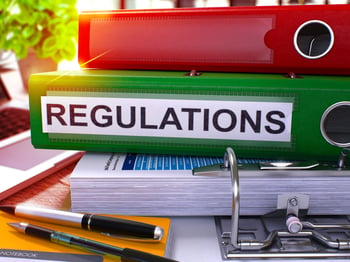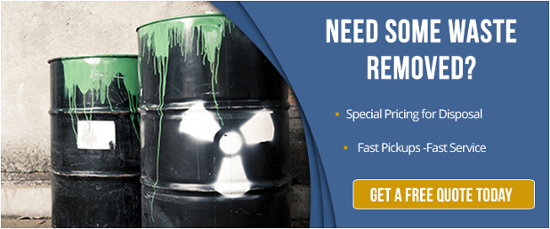Whether waste is hazardous or non hazardous isn’t always clear.
While regulatory bodies have guidelines in place that help waste generators determine whether their waste is hazardous or non hazardous, often those guidelines are gray depending on factors like where your business is located and the quantity of your waste.
If you’re trying to determine whether your waste is a threat to human health, here are some of the differences between hazardous and non hazardous waste, as well as how a disposal company can help you determine what the next course of action should be for your business.
Differences Between Hazardous And Non Hazardous Waste
It can be difficult at times to distinguish what waste is hazardous and what waste is non hazardous. However, the U.S. Environmental Protection Agency (EPA) says four clear characteristics of the waste help identify if it is hazardous:
and what waste is non hazardous. However, the U.S. Environmental Protection Agency (EPA) says four clear characteristics of the waste help identify if it is hazardous:
- Ignitability: Ignitable wastes can readily catch fire or spontaneously combust if exposed to the right conditions. This type of waste includes many cleaners, oils and used solvents. Most ignitable wastes are in liquid form, though a non-liquid waste can be considered hazardous due to its ignitability if a spontaneous fire can occur under normal handling conditions and the fire is so vigorous it creates a hazard, according to the EPA.
- Corrosivity: Corrosive wastes are acidic or alkaline and they can readily corrode human skin, metal and several other types of materials. An example of this type of waste is battery sulfuric acid. According to the EPA, aqueous wastes that have a pH greater or equal to 12.5 or less than or equal to 2 are considered corrosive.
- Reactivity: This property refers to wastes that are reactive or unstable under normal conditions. If this occurs, an explosion or release of toxic fumes, gases or vapors can follow. An example includes discarded explosives.
- Toxicity: Toxic wastes are harmful or fatal when absorbed or ingested. The EPA developed this characteristic in order to identify wastes that are likely to leach concentrations of toxic chemicals into groundwater. Examples include PCBs, mercury and lead.
The vast majority of waste produced in the United States is considered non hazardous, however. The EPA defines non-hazardous waste as “waste generated from processes associated with the production of goods and products, such as electric power generation and manufacturing of materials such as pulp and paper, iron and steel, glass and concrete.” It is not toxic, nor does it require special treatment during disposal.
Common examples of non-hazardous materials include:
- Industrial waste: Ash, sludges, antifreeze, grinding dusts and liquids contaminated with non-hazardous chemicals
- Medical waste: Plastic packaging, clean glass and plastic, paper and cardboard, aerosol cans that are completely depleted and office products
- Electronic waste: Aluminum, copper and gold found in electronic goods
How Your Disposal Is Impacted
In California, hazardous waste materials are highly regulated. Knowing what waste you generate is hazardous versus non-hazardous is critical to avoiding steep fines and any liability related to the improper storage and disposal of this waste.
Knowing what waste you generate is hazardous versus non-hazardous is critical to avoiding steep fines and any liability related to the improper storage and disposal of this waste.
The difference between the disposal of hazardous and non hazardous waste usually comes down to the type of disposal company that disposes of it for you.
In California, hazardous waste must be transported by a registered hazardous waste transporter. On the other hand, non hazardous waste can be handled by waste transporters who are not certified in handling hazardous waste.
But even if you generate non hazardous waste, there are many benefits to using a transporter that is experienced in handling both hazardous and non hazardous waste. Here are a few scenarios where working with an experienced disposal company makes sense no matter what type of waste you generate.
- Mixture of hazardous and non hazardous parts: While there are some components of electronic waste that are considered non hazardous, it can be difficult to separate these components from the hazardous parts. A hazardous waste company will ensure the entire devices are properly disposed of.
- Toxic medical waste: Nearly 15% of medical waste is considered hazardous. Although some types of non-medical waste are obvious, like office paper, others can be more complex. While one container may be nontoxic, that same container in another capacity may be toxic.
- Bulk trash: Many certified waste disposal companies have experience disposing of both small amounts and large amounts of waste. If your facility receives a constant flow of shipments, you may have large quantities of cardboard waste you need to dispose of that simply won’t fit in the trash receptacles you have on site.
- New classification: Even if you have hazardous waste on site, there are opportunities to obtain a new classification for your waste materials. Once a Treatment, Storage and Disposal Facility (TSDF) has evaluated a substance, the facility can declare it appropriate for recycling and certify that it qualifies under the excluded recyclable materials exception. Once this occurs, the approved waste streams can be re-classified as excluded materials and considered for non-hazardous waste disposal. This also means these substances are no longer included in the monthly hazardous waste measurements for hazardous waste generators, possibly saving you money since a reduction of EPA regulation requirements typically results in an increase in profitability. An experienced hazardous waste company can help you through this process in order to maximize the opportunities available to you.
There is also something else important to consider when trying to determine whether your waste is hazardous or non hazardous. Making things more complicated is the fact that states often differ in their waste laws.
Take asbestos as an example. In some states, it is considered non hazardous. In California, asbestos is considered to be hazardous. However, only asbestos waste weighing more than 50 pounds in total requires transportation by a certified hazardous waste disposal company.
A certified waste disposal company with experience in both hazardous and non-hazardous waste removal can help you navigate these different laws as well as make sure you are meeting all waste removal regulations, whether your waste is hazardous or non hazardous.
Benefits Of An Experienced Disposal Company
One of the biggest benefits of an experienced disposal company is that it can help you determine whether your waste is hazardous or non hazardous if you do not know. The best companies will have the ability to identify your waste streams through profiling and testing.
that it can help you determine whether your waste is hazardous or non hazardous if you do not know. The best companies will have the ability to identify your waste streams through profiling and testing.
Once a waste has been identified, the disposal company can certify the waste as non-hazardous, ensuring you don’t run into any trouble with the authorities during disposal.
As was the case above with asbestos, often state and local government laws differ from federal laws. A particular type of waste, like electronic waste, may be considered non-hazardous at the federal level, but considered hazardous at the state level. As a company, you’re subject to those state hazardous waste laws.
A waste disposal company can help you navigate these laws and understand how they impact your business.
While these benefits focus on helping you determine whether your waste is hazardous or non hazardous, as well as which laws may impact you, there are additional benefits to working with a certified disposal company. These include:
- Assisting you with developing site-specific plans that include training and emergency preparation
- Transporting your hazardous or non hazardous waste to recycling and disposal sites
- Preparing a manifest and other state and federal paperwork
- Providing you with proof that your waste streams were properly disposed of
The best disposal companies will also offer a hazardous waste walk-through program. This type of service is consultative in nature and focuses on areas like waste storage evaluation, emergency readiness and employee training procedures.
Hazardous Or Non Hazardous?
Knowing whether your waste is hazardous or non hazardous isn’t always obvious. The quantity of your waste and navigating state versus federal laws can leave you with different answers.
An experienced hazardous waste disposal company can assist you with understanding what type of waste you generate on your property, as well as how to properly dispose of it. Whether your waste has been deemed hazardous or non hazardous, a disposal company can also help ensure you remain confident that your waste management is sound and according to the law.


Comment